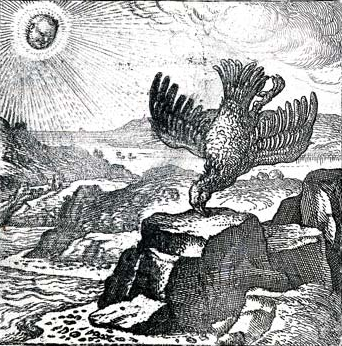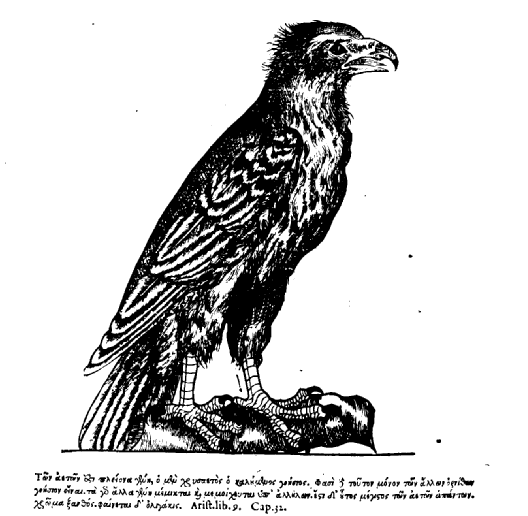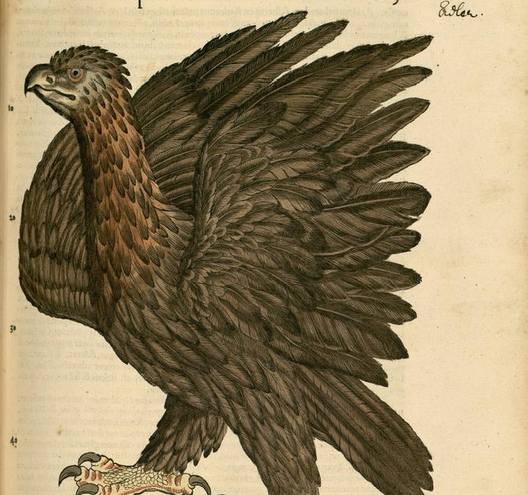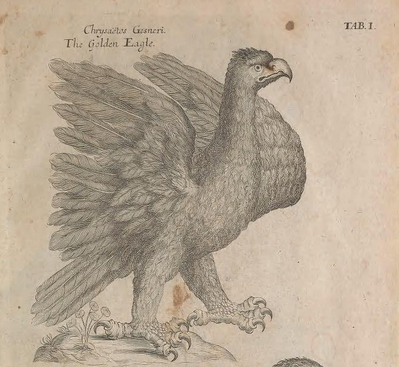Lunacy has no expiration date, especially when it comes to Crazy Animal Stories. Even so, I was astounded and delighted the other day when Suzie pointed out that the old — I mean really old — story of the eagle’s rebirth and renewal is still floating around in the new age ether.
It’s easy enough to round up some of the earliest attestations of the tale — Psalm 103 springs to mind — but I’ve started to wonder something else. As widespread and persistent as it was (is!) in the literature of allegoresis, how long did this story survive (minus its moralizing explication) in the scientific tradition?
In 1555, Pierre Belon was still repeating it in his discussion of the “naturel” of the golden eagle:
one has observed that this eagle has a long lifespan, and that when it grows old, its beak lengthens so much that it is so hooked that it keeps the bird from eating, and so it dies from that, not of an illness or its extreme old age, but from not being able to use its beak any more, which has grown so excessively.
That same year, Conrad Gesner, too, reported the eagle’s nail care, without himself endorsing the notion of renewal.
Some say that the herodius [a type of eagle] and other raptorial birds sharpen their talons and overgrown bill by grinding them against a rock when they have grown too dull to take prey. And this has been seen to be true.
Ulisse Aldrovandi, author of the most thorough early modern books about eagles, likewise appears to accept that the eagle hones its own bill and claws.
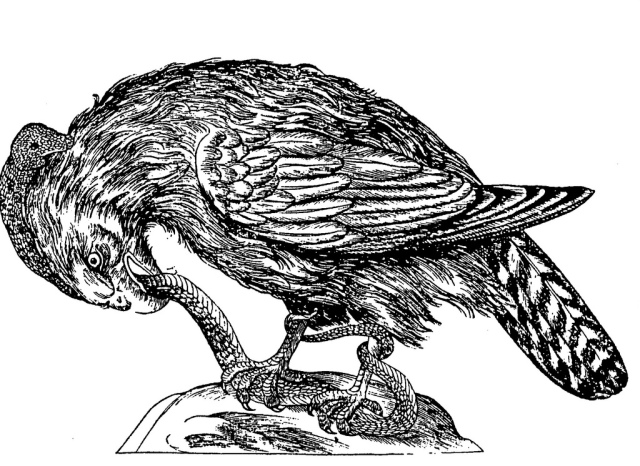
“The eagle,” Aldrovandi says, “is afflicted by very few diseases,”
chief among them dullness of vision, loss of feathers, and excessive curvature of the beak, which in old age can prevent feeding.
Aldrovandi, like Gesner and Belon, rejects the idea that simply whetting the overgrown bill to a useable state leads to any supernatural rejuvenation.
As late as the early 1650s, Johannes Jonston, much of whose Natural History was copied from Aldrovandi, was still telling the story without any indication that it might, just might, be a fiction.
As far as I know, the first clear rejection of the story of the eagle’s filing its beak and nails is that in Willughby and Ray’s Ornithologiae libri tres, published in 1676 and then, two years later, in English translation.
There are many things delivered by the Ancients and Moderns concerning the nature and conditions of the Eagle in general; [some of] which are false… [as] I take the following to be…. 10. That in extreme old age, when their Beaks by reason of their driness are grown so crooked that they cannot feed, they sustain themselves for some time by drinking…. 12. That she hath an extaordinary care of her Talons…. if by chance they be blunted, she sharpens them with her Bill, or whets them upon stones, to render them fitter for preying.
Nearly a hundred years later, Nobleville and Salerne would identify the same stories as definitively false.
The myth of the eagle’s renewal has a second part, though. Aldrovandi recounts it this way:
When the eagle is weighed down by old age, it flies as high above the clouds as it can; then the dullness and dimness of its eyes are consumed by the heat of the sun. Quickly then, with the fervor inspired in it by that same heat, it dives three times into the coldest waters; when it emerges, it returns straightaway to the nest, where its chicks have reached the age that they can hunt. As if seized by some fever, among the chicks it drops its feathers in a sweat. Until it has recovered all its feathers and down, it is fed and cared for tenderly by its young.
While the myth of the eagle and its bill strop survived into the mid-seventeenth century, this second portion of the story was dead in the scholarly water a hundred years before. Gesner offers an entirely different, entirely prosaic reason for the bird’s apparent “renewal”:
hardly any explanation for this change seems as likely as that it should be understood as the molt of the feathers. For birds that have molted, which is most readily seen in birds of prey such as eagles and hawks, seem to be renewed in a certain sense.
Aldrovandi agreed, and he took Gesner’s passage over almost verbatim into his own ornithology. In this, both stand in a tradition that reaches back to at least the thirteenth century and Albertus Magnus. Albert relates the story as told by Jorach (elsewhere, Albert says that this source “often lies”) and Adelinus (presumably the author of the Liber monstrorum), but he adds that
I have not witnessed this…. I can say nothing about this but that nature harbors many things miraculous. But what I have observed in two eagles here in our country does not confirm what they say: for those two birds were captives and molted in the same way as other raptorial birds.
Science abandoned this story early. But it survived, of course, in texts of other sorts. In the emblematic literature, for example, it supplied the pictura in emblems of baptism, penitence, and steadfastness in the face of hardship; I assume, too, that it continued to be passed along in sermons and exegetical writings, whence it trickled its way down over the centuries to the self-help section of your local Barnes and Noble.
Just one more piece of evidence proving that we as a culture aren’t quite as grown up as we like to think sometimes.

